KIC 34487- The Kepler current release data for quarters 12 and 13 shows Blahzko modulations in the time plot.
A 1901 Astrophysical Journal paper by Pickering provides a list of sixty four new variables, one of which — a star in the constellation Lyra — was found using the method above on a plate from July 13, 1899. Examination of this plate by one of Pickering’s staff, Williamina Fleming, revealed a short-period, high amplitude star (aavso.org). In nine years, she (Fleming) catalogued more than 10,000 stars. During her work, she discovered 59 gaseous nebulae, over 310 variable stars, and 10 novae. In 1907, she published a list of 222 variable stars she had discovered (wikipedia).
“RR Lyrae variables are periodic variable stars, commonly found in globular clusters, and often used as standard candles to measure galactic distances.” It is roughly estimated that out of the 200 billion stars in our Milky Way galaxy only 85,000 may be RR Lyrae stars. “They are extensively used in globular cluster studies, and also used to study chemical properties of older stars.” (wikipedia) More on RR Lyrae stars at earthsky.org.The Kepler spacecraft is monitoring a section of our galaxy that consists of approximately 150,000 stars. In a science paper J.M. Benkő et al dated 22 July 2010, the Kepler science team has identified only 29 of them as RR Lyrae stars, and of those only 14 exhibit Blazhko modulations.
It now appears that Planet Hunters has found another RR Lyrae star with Blazhko modulation making a total of 15 with Blazhko modulation.
Q12/13 phased curve for KIC 3448777
UKIRT image of KIC 3448777 at center
Daryll LaCourse:
That is one heck of a light curve! Below are the Short and Long cadence masks taken from the target pixel files for Q12. Looks like they went with a single-pixel optimal aperture centered around coordinate y981x197:SC
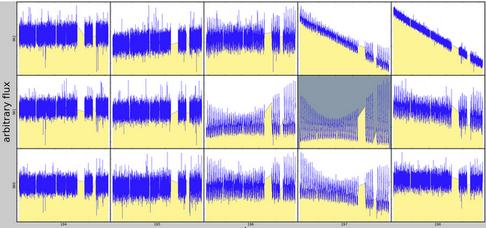
Full View
LC
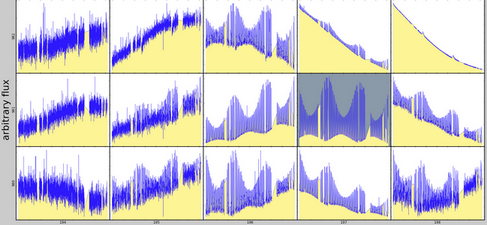
Full View
KIC 3448777 is an unlisted RR Lyrae type ab star that was first identified indirectly by Planet Hunters forum Talk member Thomas Lee Jacobs in the second quarter of 2011 as a nearby contaminator of the light curve for KIC 3448787 shown below:
The phased curve for the contaminated light curve displayed the characteristics for a RRL star which was further analyzed and confirmed by forum Talk member and co-discoverer Kian Jek. Here are some excerpts from the forum Talk thread:
Tom128 (Thomas Lee Jacobs)
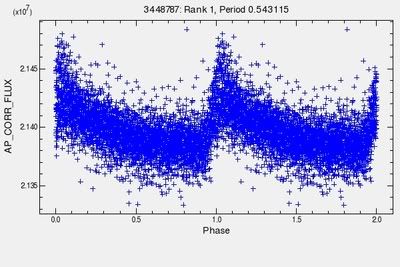
about 1 year ago
Tom128
Very interesting Kianjin. Does that mean the RR Lyrae-like pattern is a product of the glitch as well ?
about 1 year ago
kianjin
No, I was pretty sure the RRL pattern is in the star itself,
just masked by errors in photometry and/or postprocessing. Here's how
the undetrended but Kepler processed light curve looks like, Q1 to Q3:
It's strange that Q1 doesn't show any pulsations. Q2 is definitely distorted by the fp16 problem, but even Q3 has some funky distortions of its own.
So what I did was to take the raw flux from Q3 alone, detrended it myself and here's what I got - an RRL-like light curve complete with Blazhko modulation!

I'm pretty sure this is what the star should look like, and here's the final phased waveform:

I would wager a guess that it's an RR Lyrae type C. That's because the amplitude of the pulsations is less than 1%, although it has all the other characteristics, spectral class, Blazhko modulation of typical RR Lyraes.
So in the end, you were right, Tom, well done, and a great find!
about 1 year ago
Tom128
Outstanding analysis Kianjin and we netted an unlisted one as well! KID 3448787
about 1 year ago
zookeeper (moderator) (Chris Linttot)
about 1 year ago
zookeeper (moderator)
Some extra details; the reason that the variation appears and disappears between quarters might be because it's a background star; this would explain the small amplitude and if the processing used on different quarters included different parts of the image then that would explain why it comes and goes.
They also say "Any new RRLs - especially the modulated ones - are of great value and very much appreciated! Kepler provides excellent light curves and delivers surprising new discoveries on #RRLyrae stars." so do tag anything you find.
As Robert Szabo, one of the scientists says : 'Congratulations to this precious discovery'.
You can follow this star on the forum Talk thread here.


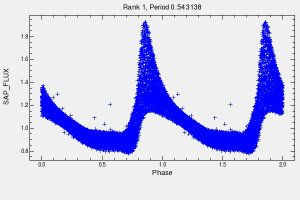
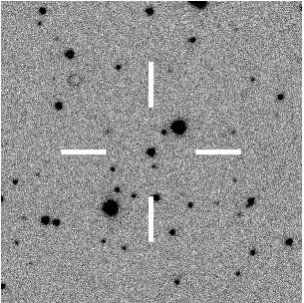


UPDATE: Oh - I know why the light curve is so crappy and not because of contamination - Q2 was imaged by mod.out 2.3 and therefore a victim of the #fp16 glitch!